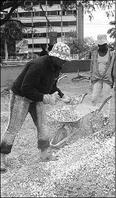
Marlon Palmer (left) and Omar Scott, participants in Phase Two of the Lift-Up Jamaica Programme, construct a picket fence at Market Street in Falmouth. - Contributed
There is time for everything under the sun - including a time to build. A visit to the real-estate pages of your daily newspaper will no doubt confirm this.
Desrene Carlton, a resident of Greater Portmore, is spending approximately $1.3 million to add two bedrooms and a living area to what was previously a quad or studio unit, purchased one decade ago, creating a newer two-bedroom house.
After paying $15,000 for her house plan and getting it approved, Carlton used an initial $450,000 from the National Housing Trust to construct the foundation and the walls. Later, she spent $132,000 for casting, $130,000 for electrical work, $300,000 for decking (roof). Labour costs for roofing alone was $150,000, and money was also spent on plumbing.
Before starting construction, the National Housing Trust advises that you are required to receive parish council approval of your design, along with a building permit.
And, in addition to your building plan, you will need to provide the council with evidence of:
Site layout
Location plan
Foundation drawings
Drainage plan - sewage disposal system
An estimator or quantity surveyor will help you to put a cost to your design. The estimator also prepares your bill of quantities. This is very important in managing the cost of your project.
Contractor
A contractor is the professional who will build your house. It is very important for you to get costs clearly outlined from the outset, and that you undertake due diligence in respect of your contractor's ability to build your house to your satisfaction.
Before construction starts, you will need to properly identify your lot. You will need to visit the site with a commissioned land surveyor, ensuring that: the correct lot and boundaries are properly identified, and that the unit is laid out within the guidelines of the covenant.
This might be costly, but it is better to have all of this done to avoid the problems that will occur and the costs you will incur if the house is built on the wrong lot.
The house that you eventually build must offer acceptable protection against natural hazards and human or animal intrusion. It should have the following features:
Structural walls with internal and external rendering
Roof and flooring - ceiling and tiling are optional
External doors and windows
Approved means of sewage and waste water disposal
Kitchen and bathroom facilities with provision for potable water and electricity.
Time-consuming

Women on a construction site. - File
Desrene Carlton says although building has been time- consuming, she is satisfied with the result, as two-bedroom houses are now on the market for $4 million and more in her area. She has saved herself approximately $2 million.
Building, she says, is something she would do again. She is yet to do the final rendering on her current project, or add windows, doors, provide bathroom fixtures and flooring, but says she will take her time to do this, completing it as and when her pocket allows.
Partial information source: National Housing Trust

